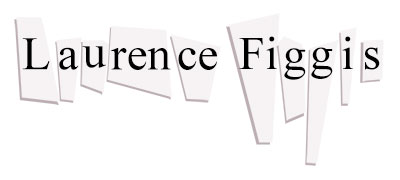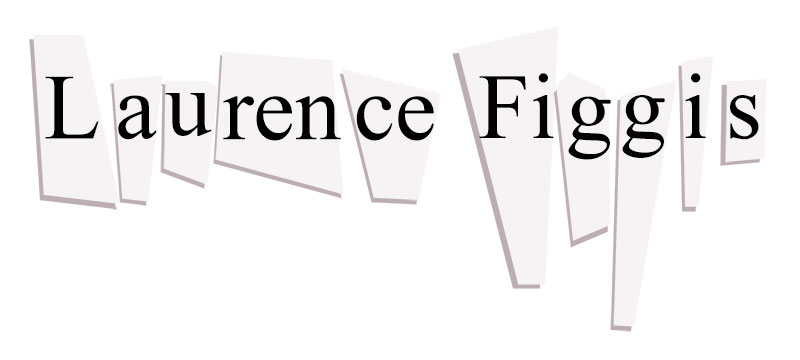Bad Retail: A Romantic Fiction (preamble)
[…] these quilted snatches are viewed as past moments – of clarity, beauty, civilization, and spiritual elation – that must somehow be retained and restitched in a sense, spliced onto the present, […] as if they were alive, as if they were types of intelligent, deathless energy, and this so as to allow the past, with a nourishing insistence, to feed the present.
(Oppenheimer 1998: 84, ‘Goethe and modernism’)
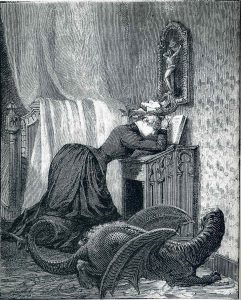
Max Ernst, Collage from Une Semaine de Bonté, 1934
The ‘romantic novel’ (a product of the late-eighteenth and early-nineteenth centuries) often tends towards a fractured compositional form. As defined by Robert Miles, the salient feature of romantic fiction ‘appears to be its failure to conform to and remain within accustomed boundaries. The generic boundaries – the seam lines – remain, just badly stitched together’ (Miles 2001: 180). As Robert Kiely observed, in his 1972 study of the genre: ‘Whereas the best romantic poetry achieves, indeed embodies, moments of synthesis, the romantic novel […] is an almost continuous display of divisive tension, paradox, and uncertain focus’ (Kiely 1972: 17). Miles attributes this tendency to the romantic interest in the subjective and the irrational (graveyard imagery, the supernatural and so forth). He concludes that while ‘such material was workable in the medium of poetry, it pulled against the qualities that had become intrinsic to the novel form: duration, a concern with community, and the objective representation of events’ (Miles 2001: 180) [1]. For today’s reader, familiar with twentieth- and twenty-first-century techniques of collage, the discordant, ‘stitched-together’ quality of romantic fiction embodies a certain formal and intellectual appeal. The surrealist Max Ernst made his collage novels (most famously Une Semaine de Bonté, 1934) from cut-up engravings to nineteenth-century gothic fictions and melodramas (the sensationalist offspring of earlier romantic literature). As Hal Foster states, Ernst’s collage ‘only articulates what is implicit in the found illustrations’. Gothic fiction is a genre ‘already given over to the unconscious, a genre in which repressed desires are hysterically expressed’ (Foster 1997 177).
My own story, ‘Bad Retail’, is a work of fiction linked to a series of narrative paintings. The term ‘collage’ is appropriate when thinking about the story’s fragmented approach to history and (cultural) memory. In the illustrations to the story, references to The Cold War and mid-century modernism coexist with images and forms inspired by symbolist, futurist and cubist painting, Rococo-style interiors and late-twentieth-century street fashion. I wanted to dramatize the equivalence of collage (as a physical – and now increasingly virtual – medium) to anachronism (a temporal displacement of images). In writing and visualising the tale, I was inspired by works of romantic historical fiction, in which the simulation of the past often fails, either because the provenance of certain objects has become confused or because the author’s contemporary sensibility moulds their description of ‘period’ costume or speech. The relationship with the practice of collage lies with the idea of displacement—an object removed from its proper time period. Similarly, the practice of collage allows a given material to be transposed (or appear to be transposed) from its specific cultural context. But if my own story is a contemporary romantic fiction, failing ‘to conform to and remain within accustomed boundaries’ (and full of tell-tale fault lines and stitches), then what generic boundaries are being delineated and convulsed? The story alludes to three narrative genres, all in some ways linked to the idea of anachronism: romantic historical fiction, literary fairy tale and dystopian fiction.
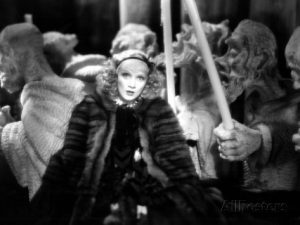
The Scarlet Empress, 1934, dir. Josef von Sternberg (film still)
Historical romance novels, like Hollywood ‘costume films’, often fail to represent the past authentically. As the fashion historian Edward Maeder has demonstrated, these glitches are not really mistakes as such; they arise out of Hollywood’s desire to seduce its audience with ‘an elaborate and excessive vision of the past’, in other words, to show history ‘through rose-coloured glasses’ (Maeder 1987: 10). Anachronism is, in this sense, the wound by which a factual (or partially factual) narrative bleeds into pure fantasy. Writers like Sir Walter Scott and Alexandre Dumas, père often drew on folklore and legend when bringing real historical events or figures to life. And the visual tropes of historical romance have in turn coloured the depiction of fantasy literature itself. In the 1960s, the British illustrator Eric Winter created a series of images for the ‘Well-Loved Tales’, an enormously popular brand of books for children published by the Ladybird group. Winter portrayed fairy-tale characters as contemporary film-star-types or fashion models, dressed in medieval or eighteenth-century costume, in settings realized with a charmingly ersatz Hollywood flavour (see Southgate 1965).
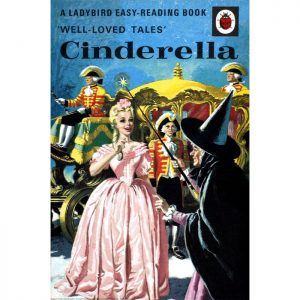
Eric Winter, Cover for Cinderella, Vera Southgate, Ladybird Books, 1963
Of course this myopic tendency—the making of history into myth—should be regarded as politically dubious. The act of nostalgia is tainted by conservatism. As Jeremy Tambling puts it: ‘the ruling class uses anachrony’ (emphasis added) to preserve the status-quo (Tambling 2010: 1). He cites Charles Dickens, writing in Bleak House (1853–54); those alarmed at the prospect of social reform ‘would make the Vulgar very picturesque and faithful, by putting back the hands upon the Clock of Time, and cancelling a few hundred years of history’ (quoted in Tambling 2010: 1). In an essay of 1949, Bertolt Brecht deplored the ‘use of fancy colours and folklore’, in the bourgeois theatre of his day, ‘to emphasize the similarities in human behaviour at different times’ (Brecht 2001: 190). He preferred a model of representation that would confirm the otherness of history. Indeed, the glamour of these sorts of images has tended to obscure the gritty realism of fairy tales themselves. As Marina Warner has demonstrated, fairy tales are culturally specific and more densely materialist than we would like to acknowledge; they bear the ‘marks’ of ordinary people who told the stories (by word-of-mouth prior to their literary inception), ‘of their lives and their struggles’ (Warner 2014: 77). The language of the stories is often terse, matter-of-fact, even when describing the most outlandish events. There are magical elements in my own story – sudden disappearances, prophetic beings and so forth. But fairy tale is not the only imaginative genre being deployed. The characters of ‘Bad Retail’ speak a sort of patois inspired by office terminology (words such as ‘file’, ‘corporation’). The language of bureaucracy points towards a different kind of (speculative) fantasy: that of George Orwell’s ‘Newspeak’ and the authoritarian language of classic dystopian narratives.
Stories about the future evoke an imaginary world. The author has to invent her nightmare—quite often, as was the case with Orwell, Anthony Burgess or Ursula Le Guin, she has to invent (or at least appropriate and adapt) a language to describe it. Slavoj Žižek goes as far as to state that Margaret Atwood’s feminist dystopian novel, The Handmaid’s Tale (1984), was written primarily to conjure an intensely subjective fantasy world. The key episodes for Žižek are those in which the protagonist, Offred, isolated in the Commander’s house, undertakes a meticulous examination of her own body and her immediate physical surroundings. For Žižek, the dystopian plot (of a right-wing patriarchal coup d’état) simply serves as the narrative frame in which the heroine can undergo this intense ‘microscopic’ experience (Žižek 2001: 121–22). He likens the conceit to ‘space operas’, where ‘planetary battles ultimately serve as a pretext for rendering the experience of floating freely in empty space without gravitation’ (Žižek 2001: 122). Certainly we might concede that the novel’s major (if subliminal) purpose is to stage a remarkably aestheticized encounter of the pre-modern past and the technological future; the handmaid’s medieval/Victorian-style red habit and ‘winged’ headdress always look ravishing in film and opera versions of the novel—a ‘sister dipped in blood’, as Atwood describes her (Atwood 1996: 19). But this sort of visual spectacle, where it arises in dystopian fiction, should not be seen as contrary to an authentic political narrative. Real-life totalitarian states have thrived on just this sort of seductive pageantry. As Tambling writes: ‘Who defines what is anachronistic is crucial: Nazi Germany’s use of advanced technology produced that strange hybrid: “reactionary modernism”’ (Tambling 2010: 1).
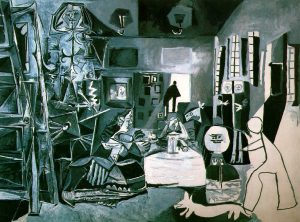
Pablo Picasso, Las Meninas, 1957, oil on canvas, 194 x 260 cm, Museo Picasso, Barcelona
Quoting from history (in and through modernity) is not just an attribute of fascism; it occurs in the aesthetic language of the twentieth-century avant-garde. In Pablo Picasso’s suite of paintings based on Las Meninas (1957) and Robert Rauschenberg’s transfer drawings illustrating Dante’s Inferno (1958–59), the act of historical appropriation (or anachronism) takes centre stage. Both recognized an ethical purpose in appropriating from history to satirize (or comment-upon) the present. Picasso saw the old regime of the seventeenth-century Spanish court (depicted by Velázquez) as comparable to 1950s’ Spain (where Franco’s dictatorship and the privilege of the monarchy endured) (see Morris 2010: 180–81). Rauschenberg visualized Dante’s Hell through images collaged from news-media and photographs of modern American life in the age of The Cold War and McCarthyism (see Krčma 2016: 167–68). For both artists, the painting and poetry of the old regime do indeed constitute a source of ‘intelligent, deathless energy’. I draw attention to their work now precisely because my own fiction began with painting (not with literature) in mind. In ‘Bad Retail’, the notion of (some kind of) royal court merges with the idea of a transcendental/mythological space, equivalent to Dante’s Hell (as imagined by Rauschenberg). Such a world may be perceived as equivalent to the idea of a painting—as it might be mythologized or satirized in contemporary culture: an object of austere hierarchy and magical separateness, of old-world charm and glamorous obsolescence. Though ‘Bad Retail’ is not strictly speaking a work of ekphrasis, though it does not ‘describe’ my paintings, it did evolve as a result of thinking about the particular challenges involved in their making [2].
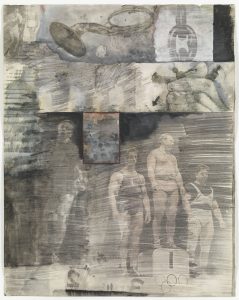
Robert Rauschenberg, Canto XXXI: The Central Pit of Malebolge, the Giants, 1959 – 60, solvent transfer, coloured pencil, gouache, pencil on paper, 36.8 x 29.2 cm, Museum of Modern Art, New York
These challenges are not dissimilar to those facing literary fiction itself. In his essay of 2000, Umberto Eco acknowledged the rising trend of the hypertext-narrative and interactive storytelling online. Not only could writers now create infinitely open-ended narratives, they could also tamper with the denouements of classic plots and inter-merge the stories of, say, Madam Bovary and Pinocchio. Eco compared the process to making a collage; for example, putting together ‘fragments of The Marriage of the Virgin, of Les Demoiselles D’Avignon and the latest Pokémon story’ (Eco 2006: 13). But, whilst acknowledging the fun creativity it might allow, he warned against the dissolution of our stable narratives (Eco 2006: 13). ‘Unchangeable stories’, he wrote, ‘make tangible’ the ‘impossibility of changing our destiny’. ‘Stories that are already made also teach us how to die’ (Eco 2006: 15).
Of course these ‘hypertext’ authors did not invent the process of using canonical literature as raw material for anachronistic collage – it had been a hallmark of magic-realist, punk and postmodern fiction, such as that of Angela Carter, Italo Calvino, Kathy Acker and Jorge Luis Borges. We should acknowledge, however, the crucial point that distinguishes such avant-garde writing from the culture of open-endedness encouraged in hypertext narratives and other digital phenomena (Internet memes, You-Tube mash-up videos and so forth). Authors such as Carter and Borges, though they convulsed generic categories in their writing, nonetheless arrived at specific and indelible outcomes that established clear parameters for their artistic visions (and their respective artistic—and political—identities) [3].
Reading from the work of T. J. Clark, we might conclude that the art-historical equivalent of Eco’s ‘unchangeable story’ is a painting with a resolved and satisfying composition. In his study of Picasso’s Guernica, he writes that ‘being, for human beings […] seems to have as its very precondition being “in”: reaching out, really or imaginatively, and feeling the limits of a place’ (Clark 2013: 281). This model of aesthetic practice, characterized by a sense of an object’s limits and its carefully worked-out internal structure, is hard to sustain in contemporary life. ‘Limits’ would seem to have no authority now in a world where objects (telling stories) are apt to be dissolved into vast networks of signs and images, subject to endless modification in ‘magnitudes that cannot be planned or anticipated’ (Joselit 2013: 19). It may be a caricature to speak of those networks as a form of ‘spatial rubble’ (to borrow a further phrase from Clark) (Clark 2013: 281). But the sublime authority of those networks, their mythical plenitude, their opportunity for unregulated transformation do indeed place strains on the other human desire: to reach out (really or in the imagination) and feel the edges of a story, the limits of a space.
Notes:
[1] The gothic novels of Ann Radcliffe and Mary Shelley are, in that respect, the epitome of romantic fiction.
[2] I originally presented sections of the ‘Bad Retail’ story in the form of printed hand-outs for the exhibitions ‘Hugs n Fun-Fun‘, The Glasgow Project-Room, Glasgow (26 October – 2 November 2013) and ‘Oh My Have’, 1 Royal Terrace Glasgow (30 March – 19 April 2015).
[3] Carter’s subversion of tropes derived from art, cinema, canonical literature and fairy tales was, above all, profoundly ethically driven. The self-proclaimed ‘moral pornographer’, Carter was ‘completely committed to historically rooted socialist materialism’ and co-opted patriarchal tropes and clichés to this end. Her appropriation of ‘mythology’ (in the sense offered by Roland Barthes) ‘functions as a subversion of those religious [and other cultural] beliefs that would restrict human freedom’ (Dimovitz 2016: 5).
References
Atwood, M. (1996), The Handmaid’s Tale, London: Vintage.
Brecht, B. (2001), Brecht on Theatre: The Development of an Aesthetic, John Willett (ed., trans.), London: Methuen.
Clark, T. J. (2013), Picasso and Truth: From Cubism to Guernica, Princeton and Woodstock: Princeton University Press.
Dimovitz, S.(2016), Angela Carter: Surrealist, Psychologist, Moral Pornographer, London: Routledge.
Eco, U. (2006), On Literature, London: Vintage.
Foster, H. (1997), Compulsive Beauty, Cambridge, MA, and London: MIT Press.
Joselit, D. (2013), After Art, Princeton and Oxford: Princeton University Press.
Kiely, R. (1972), The Romantic Novel in England, Cambridge: Harvard University Press.
Krčma, E. (2016), ‘“To use the very last minute in my life”: The Dante drawings and the classical past’, in L. Dickerman and A. Borchardt-Hume (eds), Robert Rauschenberg, London: Tate Publishing, pp. 162–88.
Maeder, E. (1987), ‘The celluloid image: Historical dress in film’, in Edward Maeder (ed.), Hollywood and History: Costume Design in Film, Los Angeles and London: Los Angeles County Museum of Art and Thames and Hudson, pp. 9–43.
Miles, R. (2001), ‘What is a romantic novel?’, Novel: A Forum on Fiction, 34:2, pp. 180–201.
Morris, L. (2010), ‘Las Meninas’, in L. Morris and C. Grunenberg (eds), Picasso: Peace and Freedom, London: Tate, pp. 178–88.
Oppenheimer, P. (1998), ‘Goethe and modernism: The dream of anachronism in Goethe’s “Roman Elegies”’, Arion, 6:1, pp. 81–100.
Southgate, V. (1965), Sleeping Beauty, London: Ladybird Books.
Tambling, J. (2010), On Anachronism, New York, Palgrave and Manchester: Manchester University Press.
Warner, M. (2014), Once Upon a Time: A Short History of Fairy Tale, Oxford: Oxford University Press.
Žižek, S. (2001), Enjoy Your Symptom: Jacques Lacan in Hollywood and Out, London and New York: Routledge.
The full-length, definitive, peer reviewed and edited version of this article is published in Journal of Writing in Creative Practice, 10 (1). pp. 5-26., 2017, https://doi.org/10.1386/jwcp.10.1.5_1
